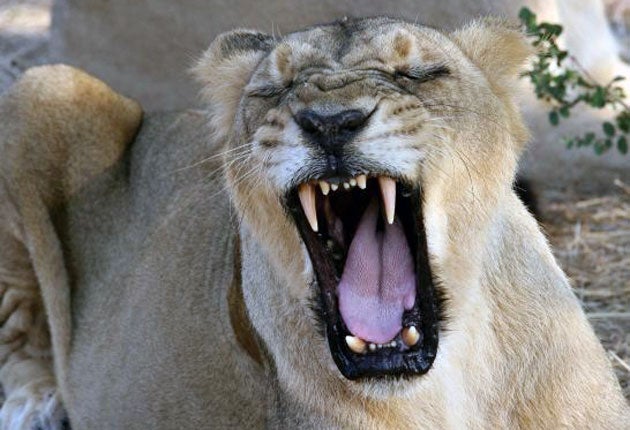Feud over lions puts a nation's pride at stake
Indian politicians argue over how best to protect the endangered big cats of Gujarat

Your support helps us to tell the story
From reproductive rights to climate change to Big Tech, The Independent is on the ground when the story is developing. Whether it's investigating the financials of Elon Musk's pro-Trump PAC or producing our latest documentary, 'The A Word', which shines a light on the American women fighting for reproductive rights, we know how important it is to parse out the facts from the messaging.
At such a critical moment in US history, we need reporters on the ground. Your donation allows us to keep sending journalists to speak to both sides of the story.
The Independent is trusted by Americans across the entire political spectrum. And unlike many other quality news outlets, we choose not to lock Americans out of our reporting and analysis with paywalls. We believe quality journalism should be available to everyone, paid for by those who can afford it.
Your support makes all the difference.The Asiatic lion is one of India's most treasured and majestic wild creatures, taking pride of place on the nation's national emblem. The animal is found in a tiny part of the western state of Gujarat and nowhere else in the world, and is now at the centre of an increasingly bitter struggle over how best to protect it from extinction.
India's federal government insists that to protect the rare lion population from the threat of an epidemic, some of the animals should be moved to a neighbouring state so the population is not concentrated in a single area and vulnerable to total wipeout. A location for this breakaway community has already been identified and millions of pounds has been spent to establish an appropriate habitat.
However, officials in Gujarat, headed by the fiery and controversial nationalist politician Narendra Modi, have defiantly refused to give up any of the creatures, insisting that the Indian government's appalling record at trying to save the tiger – whose total number now stands at little more than 3,500 – means it cannot be trusted with the fate of the lion as well. The disagreement between state and federal authorities has been going on for some time, but in recent weeks it has become increasingly vitriolic. Mr Modi clashed publicly with the Environment minister, Jairam Ramesh, and accusing him of blocking grants for other environmental projects in the state to try to pressure Gujarat over the lions.
"Lions are the pride of Gujarat," Mr Modi told a meeting in Delhi of the national planning commission. "All other states have received money for wildlife conservation; we haven't received a penny for lions. Despite this, we have been able to save the lion from poachers, unlike other states where tigers are regularly hunted down illegally."
Mr Ramesh insisted there was no attempt to discriminate against the state but admitted there was a large, unresolved problem. "There are wildlife issues with Gujarat, which are being sorted out through dialogue," he said.
The domain of the Asiatic lion once stretched across a band of territory from Greece to the north-east of the Indian sub-continent.Excessive hunting and a decline in habitat pushed the animal to the brink of extinction; experts say that 100 years ago there may have been only 50 surviving in the wild. An extensive protection programme centred on the Gir forests has seen the population rise to about 360. The story of the lion is considered a national success, with 180 bred in captivity. But zoologists have long warned that other populations should be established to protect the species against annihilation by disease.
Dr Yadvendradev Jhala, a biologist at the Wildlife Institute of India, a government-sponsored organisation that supports relocating some Gujurat lions, said: "Gujarat has done a very good job of preserving the lion. It says a lot for the efforts of the state government and they have pride in it. But the problem is that if there is a disease epidemic you [will] threaten the entire population."
Mr Jhala said authorities in Gujarat were in the process of establishing a second population about 30 miles from Gir but that to be safe, it needed to be further away. "It is a good start but 30 miles is not enough of a barrier to stop the spread of disease when there are feral dogs and such."
The central government's frustration is compounded by the fact that millions of pounds have already been spent preparing a habitat area for a second lion population in the Kuno-Palpur Sanctuary in Madhya Pradesh, 200 miles to the south-west.
Many observers believe Mr Modi's reluctance to part with some of Gujurat's lions is not just about his concerns – however real – that they might again be threatened by poachers in their new home, but because he does not want to lose the tourist revenue the animals bring in. Gir Forest National Park attracts upwards of 60,000 visitors a year. In 2008, tourists were given the chance to pay the equivalent of about £100 to watch lions devour live cattle tethered to a tree. The "attraction" was condemned by activists.
Belinda Wright, head of the Wildlife Protection Society of India, said the row between Gujarat and the federal government had come to a head because the recently-appointed Environment Minister was determined to confront the issue. "All the experts say there has to be a second lion population," she said. "But Gujarat does not want to get rid of them."
Join our commenting forum
Join thought-provoking conversations, follow other Independent readers and see their replies
Comments